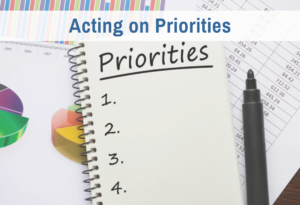“Snap out of it” is pretty useless as a piece of advice. Typically, when you tell someone to “snap out of it,” he is overreacting emotionally, or obsessing about something, or letting himself be distracted. Your advice won’t be welcome if he disagrees with your assessment. But even if he does agree, he likely already tried to “snap out of it” and failed.
At least, that’s my experience.
Fairly often, I find that I am in a mental state that is not helpful for the situation at hand. I may even know the state I need to be in to succeed. But my direct attempts to change my mental state don’t succeed. I cannot actually “snap out of it.” That is not one of the options I have. Here are some real examples:
a) Serving in tennis: All I can have in my mind as I start my swing is an intention of where I want to send the ball. If any other idea pops into mind, such as the score or how I’m supposed to swing the racket, I get distracted and mis-hit the ball. But when I notice a thought is accompanying my swing, another thought comes in — the concern that too much is on my mind. I get further “into my head” and have more work to do to get back into that poised place.
b) The urge to snack: I can open the refrigerator door for a snack and notice I am not hungry. So I close the door, and sometimes, three seconds later, I notice I am standing at the refrigerator with the door open again. Now the snacks are calling even louder and I’m still not hungry.
c) A “funk”: When I have a setback on a personally meaningful goal, I feel discouraged, as anyone would. But sometimes, this discouragement devolves into moping around. In this state, I may realize that the way out is to turn my attention to gaining values, and yet I have no answer to the question, “What values?” I then feel more discouraged.
In cases like these, the attempt to “snap out of it,” i.e., shift your mental state, fails. Typically, this failure triggers fear-based emotions that make your mental state even less conducive to the task at hand.
Why does the shift fail and what can you do in response?
Answering “why” is easy. If you have difficulty shifting your mental state, all it means is that the new state — the one you want to shift to — is not well-automatized. This is always the case when you are learning something new. Or when you are changing old habits. Or when you are shedding old baggage. It is not something to be ashamed of or distressed about.
So then, what can you do?
A second attempt to reorient is unlikely to succeed. You have further to go to create the calm, satisfied, value-oriented state that you believe you need. You are more likely to fail, and therefore likely to set up a vicious cycle.
Shutting out the distracting, mistaken, or demoralizing thoughts will not succeed. Suppressing thoughts and feelings guarantees you are not in a mental state conducive to creativity and learning.
What does succeed? Having muddled through these situations thousands of times, I have recently identified the principle. You need to take a physical pause. By a physical pause, I mean a pause that involves physical action that necessarily draws your attention out of the unproductive loop you are in, and toward some object in the world. The physical action needs to be something simple and easy for you to do, with just a simple instruction.
In the tennis example, a physical pause probably looks like letting the ball drop.
In the snack example, a physical pause may look like literally stepping away and doing a lap around the living room. Or a few jumping jacks. Or a stretch.
In the funk example, a physical pause might mean taking a short walk or other exercise. Or if that’s too ambitious, it might mean brushing your teeth or taking a quick shower. My mother used to joke that I should stand on my head when I was in a funk. About 10 years ago she sent me an article from the Wall Street Journal that reported research that showed standing on your head was a helpful antidote to depression.
A physical pause of this sort gains three immediate benefits:
1. It creates a timeout so you can let the impulses that fed a vicious cycle settle out and fade.
2. It requires you turn your attention to something neutral. You watch the ball drop so you can catch it. Or you look at the path to make sure you don’t trip. Or you monitor whether you’ve brushed all of your teeth. This necessarily lets the thoughts that were looping fade in intensity.
3. The task, being relatively short and simple, leaves you some mental bandwidth to mull over what you want to do next, given what you just noticed and that you couldn’t just “snap out of it.”
As a result of these factors, when you complete the physical task you used as a pause, you are ready and able to try a do-over to get yourself into a better mental state.
A do-over for the tennis example just means you start your tennis routine again from scratch. A do-over for the snacking example means you go back in time to before you were tempted to snack to see what was going on. Likely there is a problem there that needs your attention.
In the case of the funk, your first tiny step was the start of a do-over. You will need a series of small physical steps to get into a productive mindset. The key here is that each physical pause creates a little energy to take a next constructive step.
There is a general method here. If you are caught in a mental loop, the best way to break out of it is to take a short physical action. This switches you from trying to “solve” the problem mentally while you are in the context of the loop, to breaking the loop so you can look at the issue afresh and find a good way forward. A physical action helps you reset your mental registers so you can start over.
* * *
This tip comes out of some recent thinking about self-esteem that I will be sharing in the Thinking Lab on Tuesday. Self-esteem is the “inviolate certainty that [your] mind is competent to think and [your] person is worthy of happiness, which means: is worthy of living.” In certain crucial situations, you may realize you need to bring in that context, but “can’t” in one step. The physical pause is a crucial first step to activating that life-affirming context. Join the Thinking Lab here.









0 Comments